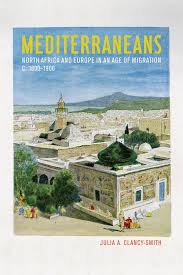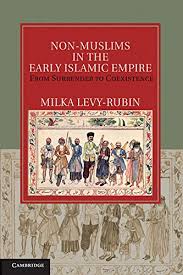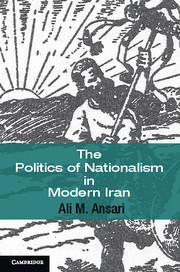-
Add to cartQuick view
Review Essay: The Transforming Landscape of Turkey’s Alevi Politics
Free!Review Essay:
Elise Massicard, The Alevis in Turkey and Europe: Identity and Managing Territorial Diversity. New York: Routledge, 2013. 255 pp.Necdet Subaşı, Alevi Modernleşmesi: Sırrı Faş Eylemek. İstanbul: Timaş, 2008. 320 pp.Add to cartQuick view -
Add to cartQuick view
Julia Clancy-Smith, Mediterraneans: North Africa and Europe in an Age of Migration, c. 1800-1900, Berkeley: University of California Press, 2011. 445 pp.
Julia Clancy-Smith, Mediterraneans: North Africa and Europe in an Age of Migration, c. 1800-1900. Berkeley: University of California Press, 2011. 445 pp.
$5.00Free!Add to cartQuick view -
Add to cartQuick view
The Imagined Christian Ecumene and the Quest for Return: Christian IDPs in Israel and the 2009 Visit of Benedict XVI
Soliciting transnational Christian authorities, such as the Holy See in Rome, and reaching out to an imagined global Christian ecumene are conventional strategies among Christians in the Middle East in their struggle to obtain benefits and negotiate their minority status at the local level. However, in the case of an internally displaced Greek Catholic village community in Israel—the people of Iqrith—when the quest for return to their destroyed 1948 village brought them into direct contact with the embodied representative of the Catholic ecumene—the pope—the practical goal of return became entangled with a more abstract and perhaps less conspicuous objective. The Christian ecumene became a field of imagination from which the people of Iqrith could challenge the restrictions experienced by Palestinian citizens of Israel and strive for global visibility. In May 2009, Pope Benedict XVI’s visit to Israel provided an opportune occasion for the materialization of an imagined Christian ecumene. This opening field of the imagination offered the people of Iqrith a way of short-circuiting the national, of inscribing the local within the global, and of “re-placing” their village on the imagined map of the world. Expressed from within the Christian ecumene, the quest for return became a means of circumventing Israeli policy and denial regarding their communal past, present, and future and of penetrating what Jean-Loup Amselle has called the “global market of identities.”
$5.00Free!Add to cartQuick view -
Add to cartQuick view
A Center of Transnational Syriac Orthodoxy: St. Mark’s Convent in Jerusalem
Free!This article highlights the role of St. Mark’s Convent in Jerusalem as a center of transnational Syriac Orthodoxy. Beginning with Manuel Vásquez’s discussions of transnational religion, it underlines the processual aspect of the transnationalism that characterizes contemporary Syriac Orthodoxy in the Holy Land, as it emerged from a mixture of pilgrimage, genocide, and diaspora as well as the combined forces of ecclesiastical expansion and changing political contexts. A complex web of relationships thus connects the community of Jerusalem to the other Syriac Orthodox groups in Bethlehem and Jordan, to the Syriac Orthodox center in Damascus and Ma‘arat Saydnaya, to the monasteries in Tur Abdin, to the faithful in India, and to the many communities in the diasporas of Europe, the Americas, and Australia. In Jerusalem this network is maintained by a narrative expressed in texts and images that combines the ancient connection to the holy places with the nationalist narrative of the lost homeland, brought together in the profuse use of Classical Syriac, the symbolic language of both church and nation.
While this community in many ways resembles the other small orthodox churches of the Holy Land, especially the Armenian and Ethiopian churches—whose members, like the Syriac Orthodox, tend to see themselves as ethnically different from the majority of local Christians—the Syriac Orthodox differ in that their homeland is a virtual one, existing primarily in the transnational network that ties all the different locations together. In the creation of this virtual homeland, Jerusalem plays a crucial role as the least political, most ecumenical, and most international of all current Syriac Orthodox centers.
Add to cartQuick view -
Add to cartQuick view
Milka Levy-Rubin, Non-Muslims in the Early Islamic Empire: From Surrender to Coexistence. Cambridge: Cambridge University Press, 2011. 267 pp.
Milka Levy-Rubin, Non-Muslims in the Early Islamic Empire: From Surrender to Coexistence. Cambridge: Cambridge University Press, 2011. 267 pp.
$5.00Free!Add to cartQuick view -
Add to cartQuick view
Ali M. Ansari, The Politics of Nationalism in Modern Iran. New York: Cambridge University Press, 2012. 327 pp.
Ali M. Ansari, The Politics of Nationalism in Modern Iran. New York: Cambridge University Press, 2012. 327 pp.
$5.00Free!Add to cartQuick view -
Add to cartQuick view
E-Transnationalism: The Case of the Christian Zionist Community in Israel
Free!The creation of the Internet has allowed religious individuals and groups to connect with other people and communities from around the world in exciting new ways. However, members of religious communities have also discovered that the Internet may not only facilitate online transactions and interactions but also complicate or hamper them. This paper seeks to better understand how one religious group—the transnational Christian Zionist community in the Holy Land—benefits from online tools and forums as well as how it contends with some of the obstacles encountered online. The author first provides an overview of the theoretical framework and methodology employed. This is followed by a summary of the religious tradition and an exploration of the ways in which the Internet affects the community, enabling them to send and receive money, objects, and information transnationally and forcing them to deal with unique challenges as well as old tensions replicated online from the “real” world.
Add to cartQuick view -
Add to cartQuick view
The Transnationalism of the Ethiopian Orthodox Tawahedo Church (EOTC) in the Holy Land
Free!The purpose of this paper is to examine the impact of transnationalism on the Ethiopian Orthodox Tawahedo Church (EOTC) in the Holy Land. It demonstrates that the EOTC is a transnational organization in a number of senses. First and most obviously, the church in the Holy Land is part of the wider network of Ethiopian churches found not only in Ethiopia but also in North America and Europe. In addition, like many other churches in the Holy Land, the EOTC serves as a seasonal hub for pilgrims who visit the holy sites, particularly on Easter. Moreover, virtually all its resources are imported from abroad. Not only the clergy (none of whom are trained at the monasteries in Jerusalem) but also religious objects, literature, and significant funds reach the EOTC from overseas. Perhaps most interestingly, during the twentieth century the transnationalism of the EOTC was not merely the result of the movement of people or objects across national borders. The redrawing of national borders in both the Horn of Africa (Ethiopia and Eritrea) and the Middle East (Israel, Jordan, and the Palestinian Authority) created yet another dimension of the church’s transnationalism.
Add to cartQuick view
- Home
- About JLS
- Issues
- Vol. 9 No. 1 | Summer 2019
- Vol 8 No 2 Winter 2018
- Vol. 8, No. 1: Summer 2018
- Vol. 7, No. 2: Winter 2017
- Vol. 7, 1: Summer 2017
- Vol. 6, Summer/Winter 2016
- Vol. 5, No. 2 Winter 2015
- Vol. 5, No. 1 Summer 2015
- Vol. 4, No. 2 Winter 2014
- Vol. 4, No. 1 Summer 2014
- Vol. 3, No. 2 Winter 2013
- Vol. 3, No. 1 Summer 2013
- Vol. 2, No. 2 Winter 2012
- Vol. 2, No. 1 Summer 2012
- Vol. 1, No. 2 Winter 2011
- Vol. 1, No. 1 Summer 2011
- Blog
- dock-uments
- Subscribe
- Submit
- Contact




